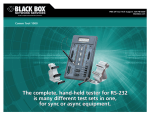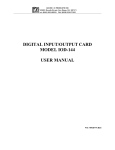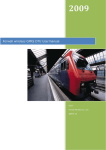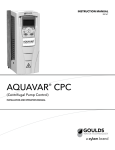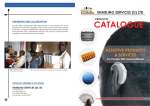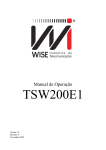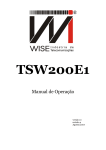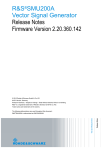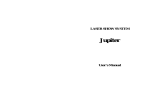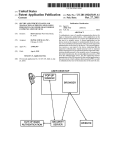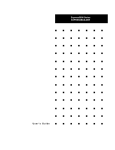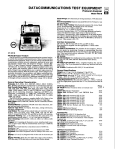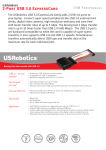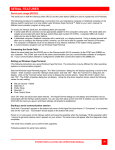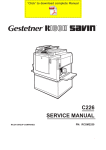Download This complete, hand-held tester for RS-232 is many
Transcript
FRee 24-hour Tech Support: 724-746-5500 blackbox.com © 2010. All rights reserved. Black Box Corporation. Comm Tool 1000 This complete, hand-held tester for RS-232 is many different test sets in one andworks with sync or async equipment. 02/22/2010 #11093 1 of 4 Use the Comm Tool 1000 to troubleshoot a variety of applications. Features » Functions as a data monitor, displaying captured data on its LCD screen. » Acts as a data trap (isolating portions of your data), a device exerciser, or a pulse-level voltmeter. » Performs BERT/BLERT testing and all RS-232 breakout box functions. » Sends and captures parallel data. » Simulates other devices so that you don’t have to attach them. Host to Terminal RS-232 cable DEC terminal cable DEC™ MicroVAX™ VT220™ terminal Comm Tool 1000 Modem to Modem RS-232 cable Comm Tool 1000 Modem Dialup or leased line Modem RS-232 cable Comm Tool 1000 OVERVIEW The compact, easy-to-carry Comm Tool 1000 can replace several other devices. It performs many different tests on your synchronous or asynchronous equipment. Use it to watch your data, test all affected serial or parallel interface signals, and find the problem fast. With this tester, you don’t have to guess what your data is doing, because you can see it in transit. The Comm Tool 1000 can perform data monitoring by capturing data and displaying it across its LCD screen. You can narrow down the search field for an error condition by trapping data with the Comm Tool 1000 (isolating only those parts of the data that you want to see). The Comm Tool 1000 performs dual-line data trapping—that is, it looks for data in both directions. Quickly analyze a mux or modem’s performance. BERT and BLERT (bit- and block-error-rate tests) compare a data pattern received from a device to the device’s normal data pattern. Using the Comm Tool 1000, you can detect numerous problems with your equipment. For example, suppose that some terminals stopped working with the host after you installed multiplexors. BERT and BLERT tests with the Comm Tool 1000 show no problems with the muxes, but when you break out RS-232 signals, you discover that some new mux-to-terminal cables are bad. 02/22/2010 #11093 724-746-5500 Check printers‘ and peripherals‘ performance. The Comm Tool 1000 acts as a device exerciser: Send a data stream to a device and then analyze the device’s output. Maybe the printer on the third floor is “acting really weird.” When you exercise it with the Comm Tool 1000, you don’t see anything unusual. But by monitoring and trapping data, you discover that form feeds and other control codes are coming from somewhere. A few more tests reveal that a spooler is improperly configured. Resolve RS-232 or parallel cabling problems fast. When you use it as a breakout box, the Comm Tool 1000 can isolate faulty pins. When you use it as a cable tester, it can isolate breaks in continuity. Test setup is easy with the Comm Tool 1000’s smart menus to guide you. And you can permanently store the test setups and messages you use most in nonvolatile memory. Versatile without being cumbersome, the Comm Tool 1000 comes in an attractive carrying case that has ample space for the unit’s power supply, manual, and other accessories. blackbox.com 2 of 4 BLACK BOX ® Technically Speaking Here are just a few tests that you can perform with the Comm Tool 1000: • D o complex sync polled devices’ testing without having to attach them to a PC, mini, or mainframe host. The Comm Tool 1000 can simulate such hosts’ presence. • You can use the Comm Tool 1000 to identify voltage-level problems in your marginal RS-232 devices. The unit functions as a pulse-level voltmeter, identifying the voltage at which your device operates. (RS-232 devices usually operate at voltages ranging from +3 to +12 volts.) • Other tests you can perform with the Comm Tool 1000 include: – Verifying whether devices are DTE or DCE; – Finding out an unidentified data stream’s data format and data rate; – T esting the serial and parallel channels’ characterper-second throughput and how closely the measured throughput approaches the ideal; –M easuring the mark/space bias distortion induced by transmission channels; – Timing events (measuring the delay between signal transitions). • The Comm Tool 1000 supports a variety of communication protocols, including asynchronous, “basic” synchronous, and SDLC (Synchronous Data Link Control), an IBM host-toterminal scheme. It also supports the Centronics parallel interface and (with the proper adapter cables) the Dataproducts® parallel interface as well. • Other applications that the unit functions well in include: – Monitoring SNA traffic to and from an IBM 3274 or similar computer; – Polling/multidrop modem testing; – Verifying the RS-232 output and control leads on an attached RS-232 device. Why Buy From Black Box? Exceptional Value. Exceptional Tech Support. Period. Recognize any of these situations? • You wait more than 30 minutes to get through to a vendor’s tech support. • The so-called “tech” can’t help you or gives you the wrong answer. • You don’t have a purchase order number and the tech refuses to help you. • It’s 9 p.m. and you need help, but your vendor’s tech support line is closed. 02/22/2010 #11093 724-746-5500 According to a survey by Data Communications magazine, 90% of network managers surveyed say that getting the technical support they need is extremely important when choosing a vendor. But even though network managers pay anywhere from 10 to 20% of their overall purchase price for a basic service and support contract, the technical support and service they receive falls far short of their expectations—and certainly isn’t worth what they paid. At Black Box, we guarantee the best value and the best support. You can even consult our Technical Support Experts before you buy if you need help selecting just the right component for your application. Don’t waste time and money—call Black Box today. blackbox.com 3 of 4 BLACK BOX ® T e c h S P e cs Code Sets — ASCII (7- or 8-bit), EBCDIC (8-bit), Baudot (5-bit), IPARS (6-bit), and Transcode (6-bit); translates to hex (5-, 6-, 7-, or 8-bit) Data Format — 5, 6, 7, or 8 data bits; even, odd, mark, or space parity (mark or space not supported with 8 data bits); and 1, 1.5, or 2 stop bits; userselectable Diagnostics — Full self-test including ROM, RAM, interface, keypad, display, alarm, and voltmeter tests Enclosure — Molded ABS plastic Flow Control — Hardware (leads user-selectable), software (X-ON/X-OFF, ACK/NAK, or user-defined), both, or none (user-selectable) Interface — EIA RS-232 (DTE and DCE), Centronics parallel, Dataproducts parallel Internal Memory — 2560 bytes of NVRAM divided into 16 variable-length buffers for storing user (test) messages; 4096 bytes of RAM for data trapping (separable into two 2048-byte buffers for dual-line trapping); additional NVRAM for storing test-setup configurations and test results Leads Supported — DB25: All; Centronics: 1 through 13 and 19 through 33 (STROBE; DATA 1 through DATA 8; ACK; BUSY; PAPER END; SELECT OUT; ground returns for the STROBE, DATA, ACK, BUSY, and PRIME leads; PRIME; FAULT; and GROUND respectively) Maximum Distance — 50 ft. (15.2 m) to any attached RS-232 device, or 20 ft. (6.1 m) to any attached parallel device, using standard cables MTBF — 78,000 hours Protocol — Asynchronous, basic synchronous, and SDLC Speed — Async: 50 bps to 19.2 kbps; Async serial: 50 bps to 38.4 kbps (user-selectable); Bias-distortion test: 110 bps to 38.4 kbps (user-selectable); Sync serial: 300 bps to 64 kbps or external clock (user-selectable); Sync BERT: 300 bps to 56 kbps or external clock (user-selectable); Parallel: Up to 15,000 cps transmit and receive User Controls — (9) Function keys; (1) ON/OFF rocker switch; (1) TRAP DISPLAY/ PRINT push button; and (3) 8-position DIP switches and (1) 5-position DIP switch for connecting/ disconnecting leads Connectors — Top-mounted: (2) DB25 female, (1) configured as DTE, (1) configured as DCE; (1) 36-pin Centronics female; (54) D-series male pins: (1) for each of the (25) broken-out leads on each of the the Comm Tool 1000’s (2) DB25 connectors; (3) for forcing voltage; and (1) for pulse trap; Side-mounted: (1) Barrel connector for AC adapter Indicators — (100) LEDs: (1) red and (1) green for each line of the interface; (1) 2-row x 16-character LCD screen Temperature Tolerance — Operating: 32 to 122˚ F (0 to 50˚ C); Storage: -4 to +158˚ F (-20 to +70˚ C) Humidity Tolerance — Up to 95%, noncondensing Power — 9 VDC from either (3) alkaline 9-volt batteries (included) or desktop power supply (also included; 115-VAC/60-Hz or 230-VAC/50-Hz input, user-selectable) Size — 3.4"H x 10.9"W x 6"D (8.6 x 27.7 x 15.2 cm) Weight — 2.6 lb. (1.2 kg) including batteries DT450A-R2 02/22/2010 #11093 724-746-5500 What’s included ✦Comm Tool 1000 ✦(3) alkaline 9-volt batteries ✦AC adapter (power supply) with an input cord suitable for North American use ✦36-inch (91.4-cm), 25-conductor ribbon cable with a DB25 male connector on one end and DB25 male and female connectors on the other end ✦36-inch (91.4-cm), 36-conductor ribbon cable with a 36-pin Centronics male connector on one end and 36-pin Centronics male and female connectors on the other end ✦Test probe ✦(5) individual and two multipoint jumper wires ✦User’s manual ✦Soft nylon carrying case You Might Also Need • Replacement batteries • RS-232 cable, to connect most devices (including the serial ports of IBM® PC/XT™ compatible PCs) to the Comm Tool 1000 • IBM AT serial modem cable, to connect your IBM AT compatible PC’s serial port to the Comm Tool 1000 • PC parallel-printer cable, to connect a PC’s parallel port to the Comm Tool 1000 • Centronics® compatible cable, to connect the Comm Tool 1000 to a parallel printer • AC and data-line surge protectors • A country-specific input cord or adapter for the power supply, to operate the Comm Tool 1000 outside of North America Item Comm Tool 1000 Code DT450A-R2 blackbox.com 4 of 4 BLACK BOX ®




